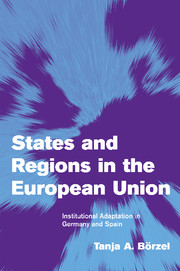Book contents
- Frontmatter
- Contents
- List of figures
- List of tables
- Acknowledgements
- List of abbreviations
- Introduction
- Part I Europeanization and domestic institutional change: A historical institutionalist approach
- Part II Reinforcing cooperative federalism: Institutional adaptation to Europeanization in Germany
- Part III Transforming competitive regionalism: Institutional adaptation to Europeanization in Spain
- 7 The Spanish State of Autonomies as a form of competitive regionalism
- 8 Toward a framework of joint decision-making: The impact of Europeanization on the territorial institutions of Spain
- 9 Conclusion
- Part IV Sharing versus shifting the costs of adaptation: The Europeanization of environmental policy-making in Germany and Spain
- Conclusions: Toward convergence in Europe?
- Appendix: The major EU environmental policies of the policy study
- List of references
- Index
7 - The Spanish State of Autonomies as a form of competitive regionalism
Published online by Cambridge University Press: 22 September 2009
- Frontmatter
- Contents
- List of figures
- List of tables
- Acknowledgements
- List of abbreviations
- Introduction
- Part I Europeanization and domestic institutional change: A historical institutionalist approach
- Part II Reinforcing cooperative federalism: Institutional adaptation to Europeanization in Germany
- Part III Transforming competitive regionalism: Institutional adaptation to Europeanization in Spain
- 7 The Spanish State of Autonomies as a form of competitive regionalism
- 8 Toward a framework of joint decision-making: The impact of Europeanization on the territorial institutions of Spain
- 9 Conclusion
- Part IV Sharing versus shifting the costs of adaptation: The Europeanization of environmental policy-making in Germany and Spain
- Conclusions: Toward convergence in Europe?
- Appendix: The major EU environmental policies of the policy study
- List of references
- Index
Summary
This chapter describes the major formal and informal institutions of the Spanish State of Autonomies. I show that the institutional culture of competitive regionalism has shaped the way in which the Comunidades Autónomas responded to challenges to their institutional autonomy by choosing a strategy of constitutional conflict and non-cooperation.
Political autonomy, fiscal centralization, and weak intergovernmental cooperation as the major formal institutions of the Spanish State of Autonomies
In an attempt to reconcile the tradition of a unitary-centralist state with the historical, cultural, and socio-economic aspirations for autonomy voiced by regionalists and national minorities, the Fathers of the Spanish Constitution of 1978 designed a system of intergovernmental relations that emphasizes the institutional autonomy of the central state and the subnational level of government. Unlike German federalism, which is based on a fusion of federal and regional powers in public policy-making (joint decision-making), the Spanish State of Autonomies is oriented toward the American model of dual federalism, which emphasizes the separation of central-state and regional powers. The sectoral distribution of competencies, asymmetrical bicameralism as well as the scarce constitutional provision for intergovernmental cooperation and vertical integration reflect an attempt to grant both levels of government a certain level of political and institutional autonomy in order to secure the cultural pluralism of Spain. Fiscal centralization and mechanisms of voluntary intergovernmental cooperation, such as sectoral conferences (conferencias sectoriales), should provide a minimum of intergovernmental integration and policy harmonization.
- Type
- Chapter
- Information
- States and Regions in the European UnionInstitutional Adaptation in Germany and Spain, pp. 93 - 102Publisher: Cambridge University PressPrint publication year: 2001

